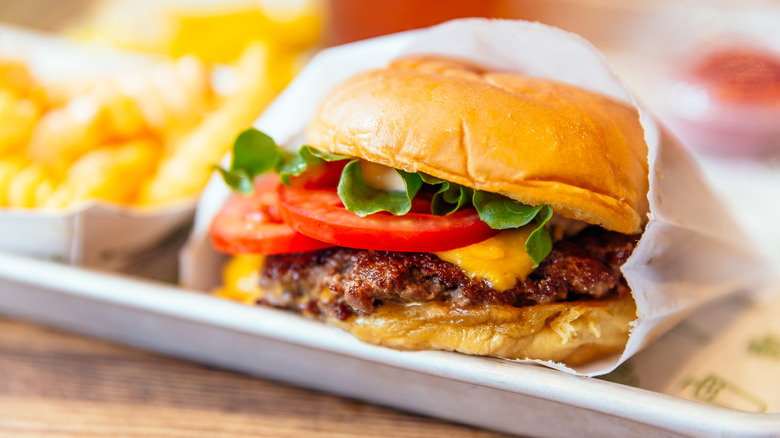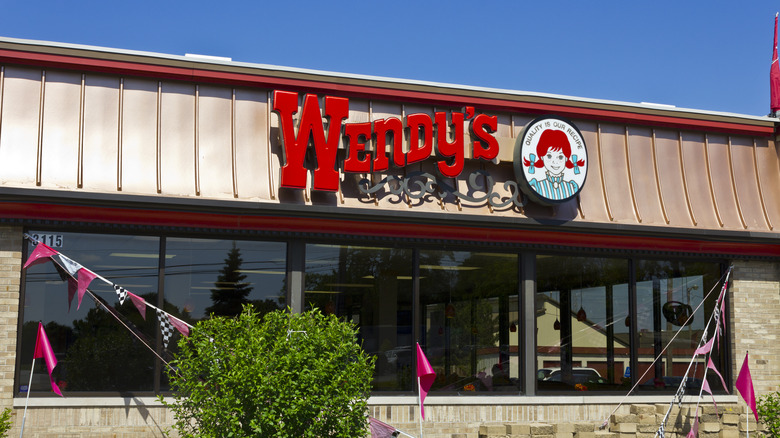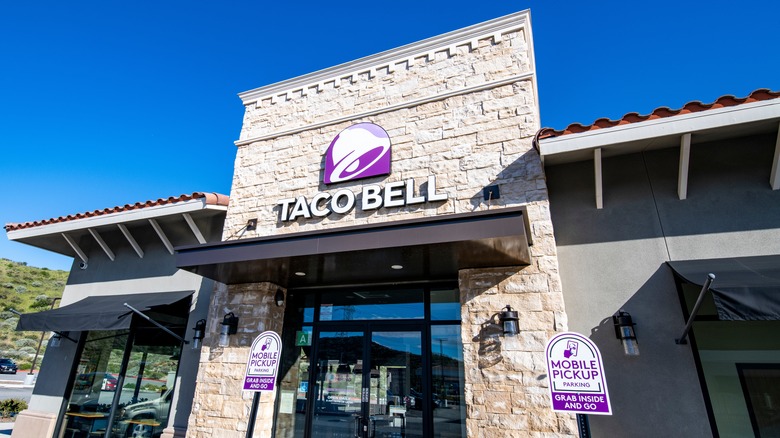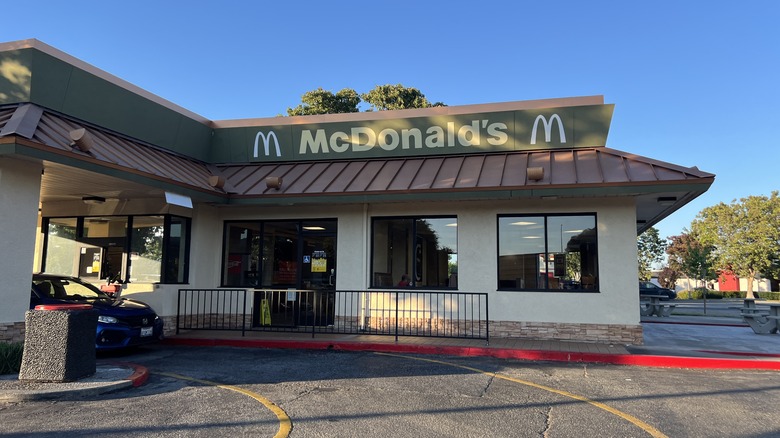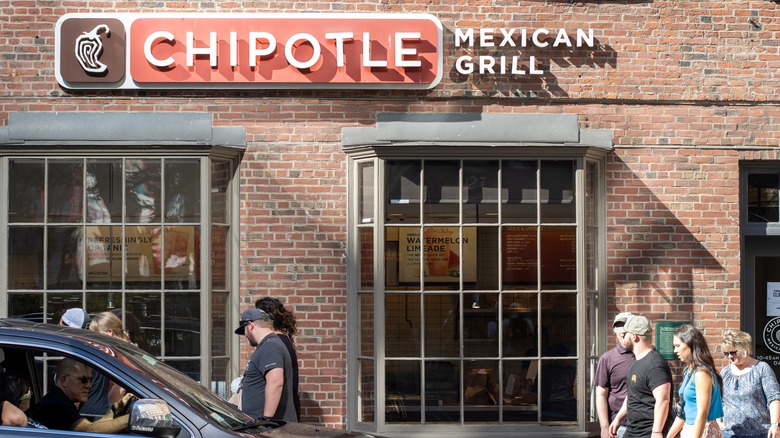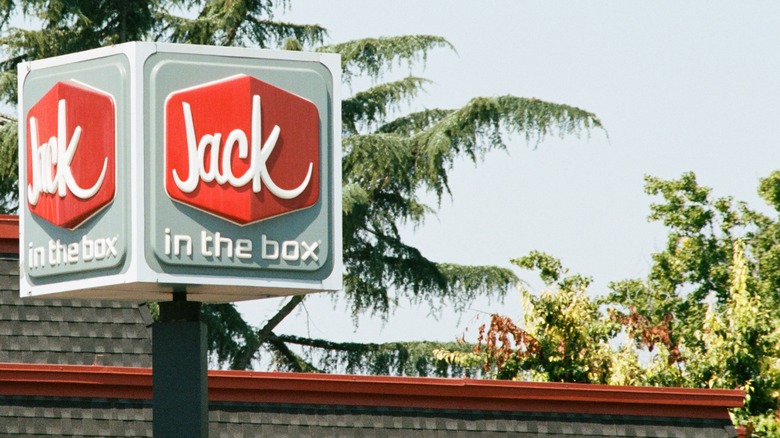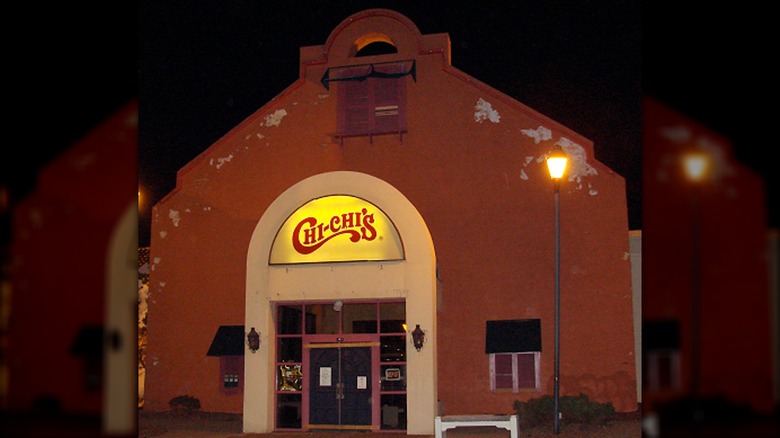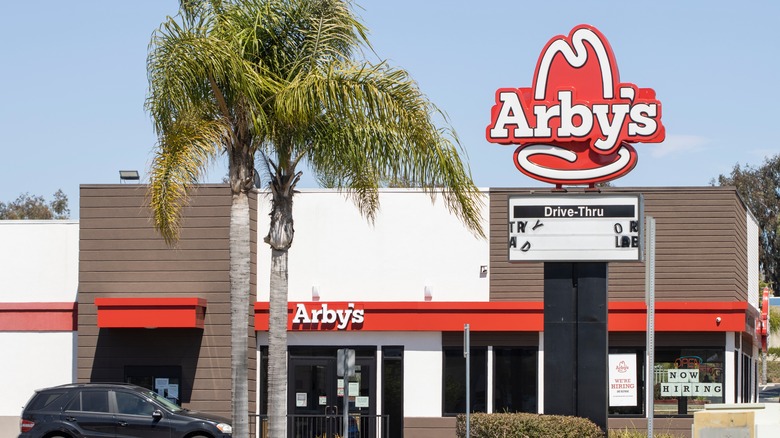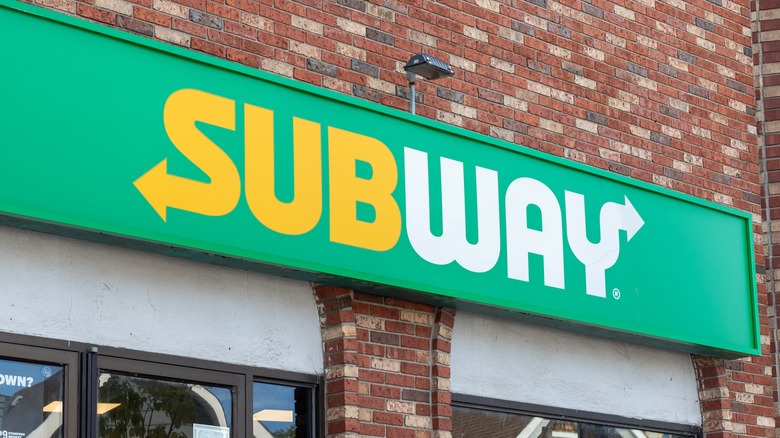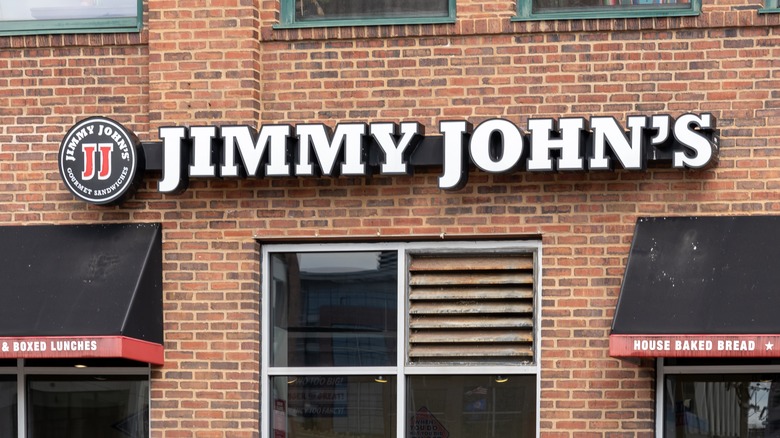Fast Food Chains With The Worst Food Poisoning Outbreaks
Rare though they may be, food poisoning outbreaks are no joke. Between the likes of salmonella, listeria, and E. coli, the Centers for Disease Control and Prevention estimates that 48 million people get sick, 128,000 are hospitalized, and 3,000 die from foodborne illnesses every year. While the image typically associated with said illnesses is food prepped in dirty kitchens or with questionable-looking meat, the reality is that bacteria, parasites, and viruses can lurk in the most unsuspecting dishes — even those purchased from a restaurant you love and trust.
That includes your go-to fast food restaurant. Not every major name in the game has been embroiled in a food poisoning scandal, but you may be surprised by the number that has. Over the years, several big chains have found themselves linked to hundreds — sometimes thousands — of cases of illness. Some of these have proven pretty monumental for the food industry, providing lessons that have helped to mitigate the risk of further outbreaks. Here's a rundown of the fast food chains with some of the most notorious food poisoning outbreaks in recent history.
Wendy's
In July 2022, an E. coli outbreak spread across six states. While an investigation by the U.S. Centers for Disease Control and Prevention (CDC) didn't manage to 100% pin down the source of the outbreak, it did find that over 80% of those interviewed had eaten at Wendy's — and the vast majority of their meals had consisted of sandwiches containing romaine lettuce.
Wendy's responded by swiftly removing romaine lettuce from its restaurants. However, that wasn't enough to stop 109 people from falling ill and 52 from being hospitalized. Of this number, at least three people suffered from hemolytic uremic syndrome (HUS), a type of kidney failure. Multiple lawsuits were filed as a result, with one Michigan family suing Wendy's for $20 million after their 11-year-old daughter spent years in the pediatric ICU and was left with permanent brain damage as a result of her food poisoning.
As is often the case with E. coli outbreaks — which cause symptoms such as diarrhea, nausea, vomiting, and stomach pain to varying degrees of severity — the reality is that this outbreak was probably even more widespread than the numbers suggested. "The true number of sick people in this outbreak is likely much higher than the number reported, and the outbreak may not have been limited to the states with known illnesses," the CDC said. The silver lining is that new illnesses ceased as soon as Wendy's pulled the lettuce from stores.
Taco Bell
E. coli struck Taco Bell in 2006, causing over 70 cases of illness and 53 hospitalizations. Just like the Wendy's outbreak, the cause was pinned down as lettuce — to be specific, shredded lettuce, as is used in 70% of the chain's products, including tacos and burritos. But that wasn't the last major outbreak to hit the Mexican-inspired chain.
Four years later, 155 people across 21 states contracted salmonella after eating at Taco Bell, which was later sued by one of the victims. Another wave of salmonella made 63 people ill in October 2011. While the U.S. Centers for Disease Control and Prevention (CDC) initially referred to the restaurant involved as "Restaurant A," this was later revealed to be Taco Bell after Food Safety News obtained a document from the Oklahoma State Department of Health's Acute Disease Service.
Considering the chain's history, questions were raised as to why the CDC didn't just clarify the restaurant responsible from the start — something it had also avoided during the 2010 outbreak. As per the CDC, it came down to a matter of needing to balance public health safety concerns with maintaining good relationships with the businesses involved.
McDonald's
McDonald's may be synonymous with burgers and fries, but it was actually its salads that triggered a wave of food poisoning from May to July 2018. After 500 people contracted a gastrointestinal illness, state and federal investigations found a link between the outbreak and salads containing a mix of romaine lettuce and salad supplied by Fresh Express. Laboratory tests later found the cyclospora parasite in said salads.
This parasite causes an illness known as cyclosporiasis, defined by an onslaught of watery diarrhea, nausea, stomach pain, and vomiting. While symptoms are usually pretty mild (or as mild as diarrhea and vomiting can be) and treated with antibiotics, they can be more serious for those with a weakened immune system, such as the very young, elderly, or those with certain health conditions. For some people, the illness can drag on for weeks or even months. As a result of the outbreak, McDonald's swiftly pulled the salad from approximately 3,000 restaurants in 14 states and changed its supplier. Two years later, the chain scrapped salads from the menu altogether, claiming that they're just not what customers want.
Chipotle
Chipotle hasn't just been struck by one mass food poisoning outbreak, or two, or even three. Instead, it experienced a whopping eight different outbreaks between 2015 and 2018, spanning norovirus, salmonella, and E. coli, affecting over 1,100 people in total.
As per the U.S. Food and Drug Administration, these outbreaks occurred as a result of employees in Chipotle's Los Angeles, Simi Valley, Boston, Sterling, and Powell stores failing to follow the chain's food safety protocols. After an investigation by its Office of Criminal Investigations, the FDA highlighted the fact that many of these employees — particularly teenagers and young adults — felt like they weren't allowed to stay at home when they were sick.
In 2020, Chipotle received a hefty fine from the FDA over its food poisoning history. The company agreed to pay $25 million, the biggest fine ever enforced in a food safety case, and to introduce a new food safety program. "Chipotle failed to ensure that its employees both understood and complied with its food safety protocols, resulting in hundreds of customers across the country getting sick," said United States Attorney Nick Hanna (via the FDA). The company hasn't remained outbreak-free in the years since, with one Colorado location investigated for a norovirus outbreak in 2021. However, these outbreaks are nowhere near as frequent as in the late 2010s.
Jack in the Box
The E. coli outbreak at Jack in the Box is one of the most infamous ever to hit fast food. In January 1993, the Washington State Department of Health noticed a concerning trend of children developing hemolytic uremic syndrome (HUS) in Seattle. More cases later emerged in Idaho, California, and Nevada. As the outbreak continued, over 700 people fell ill, 171 were hospitalized, and four children died.
Soon enough, the cause of the outbreak was traced to hamburgers sold at Jack in the Box. While the chain initially tried to shirk the blame for the outbreak, claiming that they were not solely responsible, it later admitted that it had discovered its meat was contaminated. It subsequently changed its cooking policies, requiring all burgers to be cooked for longer and all employees working on the grill to be retrained. However, that wasn't enough to mitigate the blow to Jack in the Box's sales, which dipped by up to 35% in the following months.
This outbreak is often considered a milestone in the industry. The following year, federal regulators classified the strain of E. coli (E. coli O157:H7) as a contaminant that must legally be reported to the Centers for Disease Control and Prevention (CDC) if discovered in food. It's also illegal to sell any meat found to contain said bacteria. Three decades later, the number of food poisoning outbreaks linked to hamburgers has significantly declined — one positive thing to emerge from an otherwise tragic incident.
Chi-Chi's
The food poisoning outbreak that hit Chi-Chi's in 2003 was bad enough to totally decimate the restaurant chain. First founded in 1975, Chi-Chi's was already facing financial hardships before the outbreak hit. Despite thriving in the Midwest, its expansion attempts elsewhere in the U.S. never really took off, and in October 2003, it filed for bankruptcy. Just a few weeks later, the ailing brand was hit by a hepatitis A outbreak that stemmed from green onions served at a restaurant in a Pennsylvania mall.
Over the course of the outbreak, over 650 cases were linked to Chi-Chi's, and four died. As if that's not enough, over 9,000 people who dined at the restaurant during this timeframe or came into close contact with infected customers had to be immunized. This made it the biggest outbreak of hepatitis A — a liver infection accompanied by flu-like symptoms — to hit the U.S. Ultimately, Chi-Chi's couldn't recover — especially after being forced to pay $800,000 in a class action settlement and a $6 million settlement to one victim who required a liver transplant — and it shuttered for good in 2004.
Similar to the Jack in the Box outbreak, this whole experience proved transformative for the industry. It's been directly linked to the passing of the Food Safety Modernization Act, which changed the regulations around importing food. "It allowed the FDA to recall food," said lawyer Bill Marler (via AOL). "And so that was a, you know, a big change."
Arby's
Compared to some of the other food poisoning outbreaks affecting fast food restaurants, the case that hit Arby's in 2021 was relatively minor, but still significant enough to trigger a temporary closure for one of its restaurants. Between February and April of that year, Arby's location in Springfield, Illinois, closed twice due to a wave of gastrointestinal illness that affected at least 92 people.
The restaurant initially closed for a day on February 24 when the first few illness reports rolled in, and health officials identified a temperature violation regarding unrefrigerated sauces during an inspection. One 24-hour deep clean later, the restaurant reopened — only to close again on March 8 for another deep clean and staff training after norovirus was discovered as the cause of the outbreak. Norovirus is extremely contagious, spreading through contact with infected persons or surfaces and causing approximately 19 to 21 million illnesses, 109,000 hospitalizations, and 900 deaths per year in the U.S. With that in mind, county health officials confirmed that the entire restaurant would remain closed for its top-to-bottom clean until April 1.
Subway
Between the veggies and the meats, there are a lot of moving parts at Subway restaurants. For that reason, it seems almost inevitable that the chain would face a significant food poisoning outbreak at some point. This happened in 2010 when the Illinois Department of Health linked it to 97 cases of salmonella across 28 different counties.
As per investigators, everyone affected had eaten at a Subway restaurant between May 5 and June 4. Employees at several Subway restaurants in the state also tested positive for salmonella. While everyone recovered from their illness, over two dozen victims were hospitalized at some point. One of these patients filed a lawsuit against the chain, having driven herself to the emergency room after suffering from extreme diarrhea, stomach cramps, and body aches.
To cut the outbreak short, the Illinois Department of Public Health mandated that any workers who had tested positive required a negative result to return to the restaurant. Despite a joint effort from the U.S. Centers for Disease Control and Prevention (CDC), U.S. Food and Drug Administration (FDA), Subway, and local health departments, the exact ingredient at the heart of the outbreak was never identified. Regardless, Subway ditched and replaced multiple items of fresh produce.
Jimmy John's
Another nationwide sandwich chain caught in the fire of a food poisoning outbreak is Jimmy John's. In fact, it's been caught in multiple fires over the years. In February 2020, the U.S. Food and Drug Administration (FDA) issued a warning letter to Jimmy John's after investigating five separate outbreaks of foodborne illnesses. As per its warning, Jimmy John's had "engaged in a pattern of receiving and offering for sale adulterated fresh produce, specifically clover sprouts and cucumbers," which left nearly 90 people with E. coli or salmonella in 17 states.
"Jimmy John's has not demonstrated implementation of long-term sustainable corrections to its supply chain to assure the safety of ingredients used in its products," said FDA Deputy Commissioner Frank Yiannas (via CNN). The letter came just weeks after 22 people fell ill during an E. coli outbreak in Iowa, which was also linked to Jimmy John's clover sprouts. While the restaurant responded to its letter by removing all of said sprouts (whose supplier also received a warning from the FDA) from its menu, it was also asked to provide a detailed breakdown of how it would remedy its violations within 15 days. One month later, the chain was also sued by one of the victims of its contaminated vegetables.
